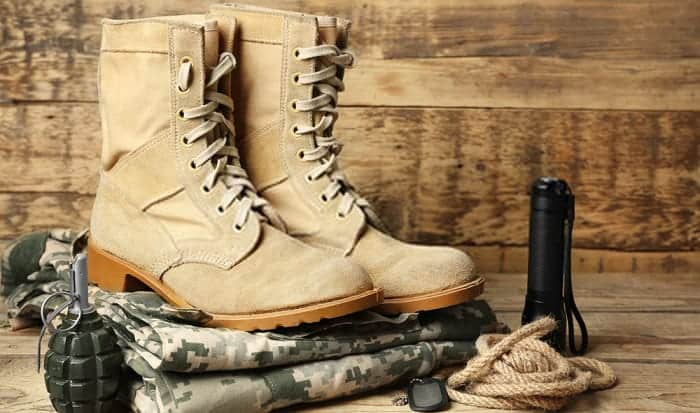The feet are the most valuable tools of any hiker. Whether you’ve hiked one mile or one thousand miles, your feet are there to carry you every step of the way. That’s why it is very important to protect them with the proper footwear.
But recently, you may have seen shoe manufacturers come out with some interesting new designs that they call tactical boots. So what are tactical boots, and are they actually better than hiking and work boots? Read on and find out.
Table of Contents
What are Tactical Boots?
The tactical boot is a special category of boot that is designed from the ground up to provide a high level of performance and protection for your feet in challenging environments and tough conditions.
Like many things that are marketed to consumers as “tactical” equipment, tactical boots are mainly inspired by the standard-issue combat boots used by the military. These combat boots needed to be durable enough to stand up to the intense wear and tear of active duty, while at the same time giving the wearer’s feet and ankles enough flexibility.
To achieve this, these combat boots were made with a leather upper and a hard rubber outsole. While these designs weren’t bad by any means, modern materials and innovations from running shoes and hiking boots have come together to create the high-performance tactical boots we see today.
What Should I Look for in Tactical Boots?
Thanks to innovations in the world of footwear, tactical boots have many interesting features and technologies that allow them to do what they do best. However, it can get a bit confusing at times as manufacturers throw all kinds of jargon at you to sell their products.
To help make things simpler for you, I’ve compiled a list of the key details you should look out for when you’re shopping around for your next pair of tactical boots:
Traction: Because they were meant to be worn by soldiers in tough terrain, tactical boots needed enough traction to keep a solid grip on everything, from shifty sands to muddy marshes. Traction can be broken down into two characteristics: the traction pattern and the outsole material.
The traction pattern refers to the way the outsole is formed. Depending on what surfaces it’s meant to grip well on, a tactical boot will usually have a combination of deep lugs (that work well on soft ground) and broad pads (that work well on hard, flat terrain).
The outsole material, meanwhile, is just that—what the outsole is made out of. Here, rubber outsoles still reign supreme, although they are now being mixed with recycled rubber as well as synthetics like PVC to improve their durability.
Cushion: Older combat boots had tough rubber soles that, while durable, got pretty uncomfortable to wear after a few hours. Modern tactical boots, however, have much more comfortable midsoles now thanks to innovations in running shoe technology.
Materials like EVA (ethylene vinyl acetate) and PU (polyurethane) foam are making their way into tactical boot designs because of their combination of excellent comfort and light weight. This is a godsend for soldiers, hikers, and just about anyone who needs to be on their feet for long periods of time.
Support: The support of a tactical boot refers to the design details that secure your feet and ankles into your boots. Altogether, these details keep your feet from slipping off of the footbed of your tactical boots, which in turn reduces the likelihood of ankle injuries while you’re on the move.
Now, these features can be a bit hard to spot, so I would recommend trying the boots on in a store to really get a feel for what these features do.
In general, though, you would want to look for a flared sole (a sole that is wider than the footbed, which gives more stability), a heel counter (a plastic piece that cups your heels), and reinforced sidewalls (additional panels on the upper or an extended midsole that prevents the foot from shifting off of the footbed).
Waterproofing: As tactical boots are designed to be used in various conditions, you can expect them to have some level of waterproofing. However, this is where the features start to get some pretty significant tradeoffs.
For instance, having really good waterproofing for traveling in the rain or wading across streams will mean that the boots have to sacrifice some breathability. That’s why you will need to seriously consider your use for your tactical boots in order to get the best experience.
Breathability: All-leather boots are well known for getting very warm. This can cause a lot of problems for people who have to wear their boots for hours at a time, as the sweat build-up from the heat can cause blisters if they aren’t careful.
Many tactical boots fix this with breathable panels made from engineered mesh and other fabrics. You’ll see this more often in tactical boots made for hotter climates. Of course, better airflow in your boots will mean that you lose waterproofing, so keep this in mind while shopping around.
Protection & other features: All tactical boots will naturally give your feet some form of protection from the elements. However, some manufacturers go the extra mile with additional features to make their tactical boots more useful in different applications.
For example, I’ve been seeing more and more tactical boots that have ASTM F2413 protection ratings. ASTM F2413 is a set of industry standards that describe the level of protection of work safety boots, and they encompass features such as impact protection, puncture resistance, and electrical shock protection.
Weight: Last but not least, you would definitely want to consider the weight of the tactical boots you are buying. This is important as the weight of your boots will strongly affect how you move in them.
Tactical boots with more protective features will typically be a bit heavier, as the extra reinforcement adds to the weight quite a bit. However, they do feel a lot more stable and grounded than lighter boots, which tend to feel more nimble and flexible.
The weight of the wearer is another important thing to consider when picking out your next tactical boots. If you have a bit of a heavier build, you will be better served with heavier boots as they will be much more stable and supportive for your feet and ankles. At the same time, heavier boots will feel really cumbersome for lighter people, so a more lightweight boot is preferred.
Are Tactical Boots Better?
As I’ve said many times in this article already, it really depends on where and how you’ll use them. Tactical boots, just like any other boot on the market, aren’t the best at every possible use. After all, you don’t go on trail runs with thick, heavy tactical boots the same way you don’t bring running shoes when you are working with heavy equipment.
That being said, tactical boots do have a lot of things on offer. And with their many variations in features and designs, I could easily recommend them as valid alternatives to purpose-built hiking or work boots.
Combining innovations and inspirations from military and high-end hiking boots, tactical boots provide a delicate balance of comfort, support, and protection for your feet, no matter where life takes you.
I hope you enjoyed reading this introductory look into tactical boots. If you have any insights or suggestions for future topics we should cover, share them with us in the comments section below.
Thank you so much for reading and happy trekking!

I am Everett Bledsoe, taking on the responsibility of content producer for The Soldiers Project. My purpose in this project is to give honest reviews on the gear utilized and tested over time. Of course, you cannot go wrong when checking out our package of information and guide, too, as they come from reliable sources and years of experience.



